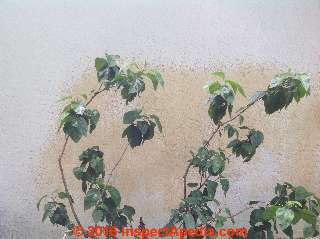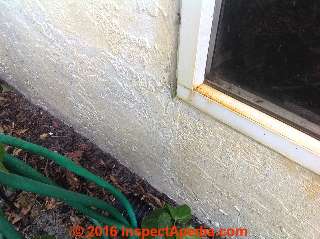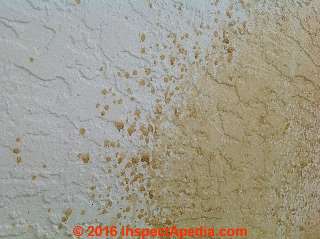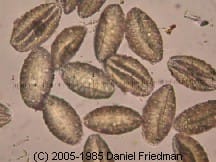 Remove Pollen Stains on Building Exteriors
Remove Pollen Stains on Building Exteriors
- POST a QUESTION or COMMENT about how to identify types & causes of stains on building exterior surfaces
How to remove pollen stains from building walls or other surfaces:
Pollen as a golden, yellow, or other-colored dust settles on building surfaces as well as anything else outdoors: cars, walks, patios. When dry it may be possible to lift off or blow off most pollen grains from a some surfaces but once physically wiped (don't do it) or soaked, the pollen may leave a colored stain that's more difficult to remove. Here we discuss these stains and how pollen stains may be removed or as a last-resort, painted-over.
This article series describes the various stains that appear in or on buildings, listing the stain cause, cure, and methods of prevention. We also include links to references useful in the identification of algae, moss, lichens, and mold.
InspectAPedia tolerates no conflicts of interest. We have no relationship with advertisers, products, or services discussed at this website.
- Daniel Friedman, Publisher/Editor/Author - See WHO ARE WE?
How to Remove Pollen Stains on Building Surfaces
Question: Golden yellow pollen stains on stucco exterior walls
2016/08/13 Colin Frankland said:
I have hard yellow orange stains running from under my flat roofed garage which are almost impossible to remove any ideas how to shift them
2016/08/16 Anonymous said:
1st time ever I have orange stain on my stucco exterior wherever I have hibiscus plants. The stain follows the shape of the plant beside it, so I know it must be from the pollen. Any idea how to remove it? Thanks - Anonymous by comment & by private email
[Click to enlarge any image]
Reply: Tips from removing Hibiscus or other flower pollen stains from walls:
Colin you can use the page top or bottom CONTACT link to send us some photos if you like; we may be able to comment further. It's helpful to have some idea of the stain source and thus its composition.
Gail:
Watch out: Do not brush the surface dry as that will smush the pollen grains into the finish and will probably make the stain worse.
If the area of staining is not large, try some adhesive tape, or masking tape to lift off most of the pollen.
For what remains, spray the stain with a household cleaner or an enzyme-based cleaner. We will discuss these in more detail below.
Before you start, send me some sharp photos of the stains if you can and I may be able to comment further.
Gail said:
Just sent 3 pics to the editor email. [Click to enlarge any image] shown here - Ed.
Moderator said:
Gail,
The stains in your photos are certainly in a location and of a color to blame on pollen from the adjacent hibiscus plants.
Once rain or hose-spray smashes the pollen onto the painted surface of the stucco it's no longer a powder that will just lift-off: just as you report.
From what we read in some scholarly articles about the composition of pollen, there are probably some fatty acids that are along with pigmented cells, and along with other chemicals we've not listed, that conspire to both adhere to the wall surface and perhaps to leach into the painted coating. Sporopollenin, a pollen component is insoluble in most common solvents.
The pollen grains shown above, photographed in our laboratory, illustrate the pollen of the Tulip Poplar or Yellow Poplar Tree. See this and more images of pollen under the microscope at POLLEN PHOTOGRAPHS.
Cleaners Safe to Use on Pollen Stains on Walls
- I would try gentle washing first with a liquid kitchen dish-washing detergent
that includes a degreaser feature. Use a sponge or soft bristle brush, wash the surface, then rinse thoroughly. - Safe solvents to try include vinegar, rubbing alcohol, and an enzyme-based household cleaner.
Some reports I reviewed claimed success using a shampoo or a kitchen cleaner that included a de-greasing agent. - I read a report of success at removing pollen from building surfaces using a Mr. Clean Magic Eraser
produced by Mr. Clean, a Proctor & Gamble company and available at many supermarkets. - I also read one report of successful removal of pollen from car surfaces,
including convertible tops using a car cleaning product such as Optimum No-Rinse™ Wash & Shine produced by Optimum Polymer Technologies - a cleaner that does not use soapy surfactants. - What about using a bleaching agent?
If your stucco is white or near white you might try a dilute bleach spray or an existing spray product containing bleach, but first have that garden hose handy and wash down the wall quickly enough to avoid bleach run-down discoloration of your paint. I often have success using a milder non-bleaching spray cleaner such as Windex followed by a garden hose spray-off.
Enzyme-based cleaners to try on Pollen Stains on Walls
- Pet stain removers
- Laundry detergents using enzyme agents (biological compounds)
- Kitchen & bathroom cleaners using enzyme agents
- Some mold cleaning sprays
What to Do when the Safe Easy Cleaners Don't Remove Pollen Stains from Building Surfaces
If you're of a scientific-curiousity-bent and want to fool with solvents:
Shaw (1966) discussed the chemical composition of pollen and thus doubtless its coloring pigments as well.
Though warned-off by Domínguez (1999) I'd try some common household solvents, testing the solvent first on an inconspicuous area of siding so as to determine if the solvent is going to take off paint too - you probably don't want to dissolve the paint if you can avoid it. As organic solvents may work on pollen stains, try an odorless paint thinner - that will most likely not do much to the paint itself. Be sure to read the usage safety warnings.
Paint cleaning chemicals, TSP substitutes, and deck cleaning agents may work but except for the TSP substitute may be a bit harsh on your painted stucco.
More dangerous chemicals like dry cleaning solvent might work but are not so safe to use; acetone would probably work (nail polish remover) but is not so safe to work-with.
Seal & Paint Stained Surfaces That Won't Come Clean
If you cannot remove the stains with safe solvents that don't harm the painted surface (and that's difficult once the pollen has gotten wet), I'd consider a paint-over: on a dry surface, use a lacquer primer-sealer that is likely to have least stain bleed-through, then re-paint the wall area in its original color.
Composition of Pollen & Pollen Stains on Building Surfaces
Also see POLLEN PHOTOGRAPHS at InspectApedia.com
- Almeida-Muradian, L. B., Lucila C. Pamplona, Sı́lvia Coimbra, and Ortrud Monika Barth. "Chemical composition and botanical evaluation of dried bee pollen pellets." Journal of food composition and analysis 18, no. 1 (2005): 105-111.
- Campos, Maria GR, Stefan Bogdanov, Ligia Bicudo de Almeida-Muradian, Teresa Szczesna, Yanina Mancebo, Christian Frigerio, and Francisco Ferreira. "Pollen composition and standardisation of analytical methods." Journal of Apicultural Research 47, no. 2 (2008): 154-161.
- Domínguez, Eva, José A. Mercado, Miguel A. Quesada, and Antonio Heredia. "Pollen sporopollenin: degradation and structural elucidation." Sexual Plant Reproduction 12, no. 3 (1999): 171-178.
Abstract:
We report the isolation of purified sporopollenin from pollen grains of different species and its complete solubilization. Exine from Pinus pinaster, Betula alba, Ambrosia elatior and Capsicum annuum was extracted by treatment with hydrogen fluoride in pyridine. These exines were purified from their aromatic moieties and from fatty acids linked by ester bonds using acidolysis and saponification treatments.
The biopolymer obtained retains almost completely the shape of the original pollen grain. Fourier-transform infrared spectroscopy analysis of the isolated sporopollenin showed the absence of polysaccharide and phenolic material and the presence of carboxylic acid groups joined to unsaturations and ether linkages.
Sporopollenin samples were successfully degraded by exhaustive 24-h ozonolysis at room temperature.
Gentle ozonolysis (3 h at 0°C) did not completely degrade the biopolymer. The compounds obtained after exhaustive ozonolysis were analysed by gas chromatography-mass spectrometry.
Dicarboxylic acids with a low number of carbon atoms were identified as major components of sporopollenin from P. pinaster, A. elatior and C. annuum, representing 28.8%, 63.2% and 88.5%, respectively, of the total compounds obtained.
Fatty acids and n-alkanes also were identified in P. pinaster, A. elatior and B. alba sporopollenin. From the data obtained, an hypothesis about the chemical nature and structural arrangement of the sporopollenin is proposed. - Pacini, Ettore, and Michael Hesse. "Pollenkitt–its composition, forms and functions." Flora-Morphology, Distribution, Functional Ecology of Plants 200, no. 5 (2005): 399-415.
- Shaw, G., and A. Yeadon. "Chemical studies on the constitution of some pollen and spore membranes." Journal of the Chemical Society C: Organic (1966): 16-22.
Abstract:
The membranes of Lycopodium clavatum spores and Pinus silvestris pollen grains are similar, and have been found to consist approximately of cellulose (10—15%), an ill-defined “xylan” fraction (10%), a lipid fraction (55—65%) which on oxidative degradation gives a mixture of non-branched mono- and di-carboxylic acids with 16 carbon atoms or less, and a lignin-like fraction estimated to be 10—15%. The significance of these results is discussed.
...
Continue reading at STAIN DIAGNOSIS on BUILDING EXTERIORS or select a topic from the closely-related articles below, or see the complete ARTICLE INDEX.
Or see these
Recommended Articles
- MOLD APPEARANCE - STUFF THAT IS NOT MOLD
- STAINS on & in BUILDINGS, CAUSES & CURES - topic home,
- STAIN DIAGNOSIS on BUILDING INTERIORS
Suggested citation for this web page
POLLEN STAINS on BUILDINGS at InspectApedia.com - online encyclopedia of building & environmental inspection, testing, diagnosis, repair, & problem prevention advice.
Or see this
INDEX to RELATED ARTICLES: ARTICLE INDEX to BUILDING STAINS
Or use the SEARCH BOX found below to Ask a Question or Search InspectApedia
Ask a Question or Search InspectApedia
Questions & answers or comments about how to identify types & causes of stains on building exterior surfaces.
Try the search box just below, or if you prefer, post a question or comment in the Comments box below and we will respond promptly.
Search the InspectApedia website
Note: appearance of your Comment below may be delayed: if your comment contains an image, photograph, web link, or text that looks to the software as if it might be a web link, your posting will appear after it has been approved by a moderator. Apologies for the delay.
Only one image can be added per comment but you can post as many comments, and therefore images, as you like.
You will not receive a notification when a response to your question has been posted.
Please bookmark this page to make it easy for you to check back for our response.
IF above you see "Comment Form is loading comments..." then COMMENT BOX - countable.ca / bawkbox.com IS NOT WORKING.
In any case you are welcome to send an email directly to us at InspectApedia.com at editor@inspectApedia.com
We'll reply to you directly. Please help us help you by noting, in your email, the URL of the InspectApedia page where you wanted to comment.
Citations & References
In addition to any citations in the article above, a full list is available on request.
- [1] Hugh Cairns, RHI (Registered Home Inspector), Subject 2 Inspections, Mr. Cairns is a licensed professional home inspector and thermographer serving Kelowna, Vernon, and Penticton, British Columbia. Tel: 250.808.5777, Email: okanagan@subject2homeinspections.com
- Analysis of Modern Paints, Thomas J.S. Learner, Research in Conservation, 2004 ISBN 0-89236-779-2 [Chemistry of modern paints, overview of analytical methods, pyrolysis-gas chromatography signatures of basic modern paints and their constituents, Fourier transform infrared spectroscopy for paint analysis, direct temperature-resolved mass spectrometry, and analysis in practice - technical reference useful for forensic paint science, focused on art works -DF]
- Art, Biology, and Conservation: Biodeterioration in Works of Art, Robert J. Koestler et als. Eds., Metropolitan Museum of Art, 2003, ISBN 1-58839-107-8
- Building Pathology, Deterioration, Diagnostics, and Intervention, Samuel Y. Harris, P.E., AIA, Esq., ISBN 0-471-33172-4, John Wiley & Sons, 2001 [General building science-DF - ** Particularly useful text **
- Dampness in buildings, Diagnosis, Treatment, Instruments, T.A. Oxley & E.G. Gobert, ISBN 0-408-01463-6, Butterworths, 1983-1987 [General building science-DF]
- Certainteed Weatherboard fiber cement siding and trim products - see certainteed.com/ or see certainteed.com/resources/sidingandtrimspecsheet.pdf
- "Moisture Control in buildings: Putting Building Science in Green Building," Alex Wilson, Environmental Building News, Vol. 12. No. 5. [Good tutorial, "Moisture 101" outlining the physics of moisture movement in buildings and a good but incomplete list of general suggestions for moisture control - inadequate attention given to exterior conditions such as roof and surface drainage defects which are among the most-common sources of building moisture and water entry.--DJF]
- MASONITE WOODRUF® ROOFING OR MASONITE OMNIWOOD® SIDING LAWSUIT SETTLEMENT NOTICE - PDF file
- Paint Handbook: testing, selection, application, troubleshooting, surface preparation, etc., Guy E. Weismantel, Ed., McGraw Hill Book Company, 1981, ISBN-10: 0070690618, ISBN-13: 978-0070690615, [Excellent but a bit obsolete paint theory and practice, also a bit light on field investigation methods, out of print, available used-DF]
How to select and apply the right paint or coating for any surface. The first major reference to help you choose the correct paint or other finish to do the job best on a particular surface exposed to a particular environment. Experts in the field give full advice on testing surface preparation, application, corrosion prevention, and troubleshooting. The handbook covers wood, metal, composites, and masonry, as well as marine applications and roof coatings. A ``must'' working tool for contractors, architects, engineers, specification writers, and paint dealers. - Paint and Surface Coatings, Theory and Practice, R. Lambourne & T.A. Strivens, Ed., Woodhead Publishing Ltd., William Andrew Publishing, 1999 ISBN 1-85573-348 X & 1-884207-73-1 [This is perhaps the leading reference on modern paints and coatings, but is a difficult text to obtain, and is a bit short on field investigation methods - DF]
Provides a comprehensive reference source for all those in the paint industry, paint manufacturers and raw materials suppliers, undergraduate and postgraduate students, and industrial paint users. R. Lambourne was in the Research Department at ICI Paints Division and the Industrial Colloid Advisory Group, Birstol University, UK. - Seeing Through Paintings, Physical Examination in Art Historical Studies, Andrea Kirsh, Rustin S. Levenson, Materials in Fine Arts, 2000 ISBN 99-051835 [ forensic science, technical reference, focused on art works - DF]
- Soiling and Cleaning of Building Facades (RILEM Report), L.G.W. Verhoef (Editor), Routledge; 1 edition (November 3, 1988), ISBN-10: 0412306700, USBN-13: 978-0412306709
The report of a comprehensive investigation by RILEM which examines all aspects of the cleaning of facades, subject to soiling by both biological and non-biological agencies. The contributors are international authorities working in this field giving essential advice to all those who need to know how to approach the problems connected with the soiling and cleaning of building facades. - Staining, Prevention of Premature Staining in New buildings, Phil Parnham, Taylor & Francis; 1996, ISBN-10: 0419171304, ISBN-13: 978-0419171300
The appearance of ugly staining early in a buildings life, ruins an otherwise pleasing appearance, tarnishes the image of the owners and gives rise to costly refurbishment works. In this book Phil Parnham raises a number of questions that should be considered whenever a new building is being designed or built. These are: * why has staining become so prominent; * what causes premature staining; which parts of new buildings are likely to be affected; * how can it be avoided? By using a number of highly illustrated case studies, the author answers these questions and ends by suggesting measures that should be taken by all design and construction professionals to prevent premature staining. - In addition to citations & references found in this article, see the research citations given at the end of the related articles found at our suggested
CONTINUE READING or RECOMMENDED ARTICLES.
- Carson, Dunlop & Associates Ltd., 120 Carlton Street Suite 407, Toronto ON M5A 4K2. Tel: (416) 964-9415 1-800-268-7070 Email: info@carsondunlop.com. Alan Carson is a past president of ASHI, the American Society of Home Inspectors.
Thanks to Alan Carson and Bob Dunlop, for permission for InspectAPedia to use text excerpts from The HOME REFERENCE BOOK - the Encyclopedia of Homes and to use illustrations from The ILLUSTRATED HOME .
Carson Dunlop Associates provides extensive home inspection education and report writing material. In gratitude we provide links to tsome Carson Dunlop Associates products and services.




